Automate & Get Leads with Project Broadcast for any Business (2023 Guide)
If you want to get more leads, you should automate & get leads with Project Broadcast for any business. You have come to the right place. This way, you can focus on other important aspects of your business while still generating a consistent stream of leads. There are many different ways to automate your lead generation, so talk to a marketing expert to find the best solution for your business.
What is project broadcast?
Stop playing phone tag. Text marketing blows away traditional marketing every time. Recent statistics prove that text messaging isn’t just a viable communication channel for businesses to use, it’s the most effective means of communication.
As you think about your business and how you want it to grow, you’re likely considering systems for tasks such as customer follow up, coaching, prospecting, messages of gratitude, alerting customers of sales and promos etc. Now you can use the power of text messaging to maintain one-to-one connections with every customer!
These are the current features:
- Free Phone Number with your Area Code
- Unlimited Chats
- Unlimited Incoming Reply
- Unlimited Messaging Campaigns
- Sharable Campaigns (Here are a few of mine)
- Determine your own broadcast hours
- Spaces allows for Group Team Collaboration and service
- Direct Sales Party for Network Marketers
- Provides Unlimited Contacts
- IOS and Android App
- Personal Touches
With Project Broadcast, you can tackle all of these items with ease. Let Project Broadcast do the heavy lifting for your business so you can focus on what you do best: building relationships!
Why use a text messaging system (SMS)?
A text messaging system (SMS) is a system that allows users to send and receive text messages. SMS is a popular communication tool because it is fast, easy to use, and available on most mobile phones. SMS can be used to communicate with friends, family, and businesses.
Because everyone uses it...and the further we get into our phones the only thing we answer is text or messages or social media.
However you have to do it the right way by build rapport with your customers.
The recent pandemic forced many businesses to change their plans and most small business owners had to reevaluate how they would move forward. Brick and Mortar Business Owners were especially affected because they usually rely on foot traffic to stay in business and they didn’t have that option. Many businesses closed their doors, while some grew and thrived larger than ever. How did they do that? They had to PIVOT!, as Ross Gellar would say.
How does project broadcast work?
Let's say you are a vendor and would like to start getting more leads. Try this strategy out!
When setting up a booth at a vendor fair, I always plan to offer free samples! After all, it is the best way to get people to try my new product without the pressure of the sale. Before a vendor fair, I set up a keyword in my Project Broadcast’s keyword tab. This keyword will trigger an auto-response message and follow-up campaign automatically. This saves me a ton of time. I can even send the customer a survey in that auto-response.
Here’s how the process works. I use a specific keyword, let’s use “sample”, and on my vendor booth I advertise my keyword with “to request a free sample of (specific product) text “sample” to (my project broadcast number.) When the keyword is texted to my Project Broadcast number, they will receive an auto-response message. Here is my example of the auto-response message I send back:
Hey!! Thanks so much for stopping by my vendor booth! To get your free sample please click the link (configurable form linke) to fill out your name and address so I can get your sample in the mail.
The link takes them to a Project Broadcast configurable form. This form will have questions that I created in our custom fields section, that will give me the name of who is texting and their address to mail their sample to. I also make sure the keyword is joined to a drip campaign that goes out when the keyword is triggered. The drip campaign is set up to follow up at 2 days, 7 days, and 14 days after they trigger the campaign by texting me the keyword. Here is an example of my drip campaign follow up messages:
Two days after:
Hey (first name)!! I just wanted to give you an update, your free sample is in the mail. I can’t wait for you to try (specific product)!
Seven days after:
Hey (first name)!! I just wanted to follow up and make sure you received (specific product) in the mail. Have you had a chance to try it yet?
Fourteen days after:
Hey (first name)! How did you like (specific sample)? Did you have any questions?
Project Broadcast Has Some Amazing Features
Messaging
Spaces NEW (Teams or Consultant)
Collaborate with your family, friends or team members all in the same place.
Unlimited Chat (Text Parties)
Chat back and forth one on one via your Project Broadcast chat tab with your contacts without the worry of using credits.
Free Incoming Messages
Rest assured when receiving messages because all incoming SMS and MMS messages are unlimited and free!
Unlimited Contacts
Create unlimited contacts manually or by using our smart CSV importer. Five or five thousand. No Limits!
File Attachments
Send an unlimited number of files to your contacts for download and see who downloaded them.
Archiving
Lead gone cold? Archive them to remove them from your view and hide their chat.
Personalization
Dynamic Fields
Make your messages personal with the inclusion of dynamic fields such as first name.
Custom Fields
Store info that is important to you for your contacts. Each contact has 20 custom fields.
Configurable Forms
Create an unlimited number of personalize custom forms to have your contacts fill out.
Broadcast Hours
Don’t want to have messages send out on your day off? Leverage broadcast hours to manage when Project Broadcast will send on your behalf to your audience.
Tags
Keep contacts organized using an unlimited number of tags. Tag contacts manually, when using keywords, or when importing.
Contests
Run contests and pick winners at random using an unlimited number of contests.
Automation
Scheduled Broadcasts
Easily schedule a message to as many contacts as you like on a specific date and time.
Built In Stop/Start
Built in support for handling stop/start incoming messages from contacts. Contacts are marked as Do Not Message automatically on an incoming stop message.
Campaigns
Create unlimited campaigns. We support Drip, Time Lapse, Calendar, Anniversary, Repeating, Countdown and Birthday campaign types. Fast Forward campaigns for easy testing.
Templates
Store commonly used text messages, images, and voicemails in an unlimited number of templates for easy access in the future.
Unlimited Keywords
Create unlimited keywords to auto-reply with messages, put contacts into campaigns, and tag them easily.
Bundles
Share attachments, campaigns, keywords, landing pages, and templates with other users via our bundles feature.
Insights & Analytics
Unsent Messages
Understand carrier message failure reasons via the unsent messages.
Trackable Links
Understand engagement with your contacts via an unlimited number of trackable links.
Message Insights
Use our industry leading message insights feature to understand your messages deliverability rating.
Stats
Understand your usage with numerous stats available for your account.
Additional Features
SMS and MMS
Send text messages with up to 1024 characters including emoji and image support. SMS and MMS messages are just 1 credit.
Auto MMS
Auto MMS keeps your SMS messages intact by sending as an MMS when your message is longer than 160 characters or 80 with an emoji.
Call Forwarding
Share your Project Broadcast number as your business number and have incoming calls forwarded to your real phone.
Outbound Calling
Use your Project Broadcast number to make outbound calls to your contacts.
Voicemail Drops
Send recorded messages straight to your contact’s voicemail for higher engagement and a multi-faceted approach. Voicemail drops are only 2 credits.
How to use project broadcast?
Automate anything with Project Broadcast Integrations from Zapier!
Project Broadcast Integrations from Zapier can help you automate your project management processes by integrating with popular project management software. With Zapier, you can connect to over 1,000 apps to automate your workflows, including Asana, Basecamp, Trello, and more. Project Broadcast Integrations can save you time by automating repetitive tasks, such as creating new projects, adding tasks to projects, and sending notifications.
What is automation?
Automation is simply setting something up to run automatically. Automation is all around you, even if you don't realize it. Take your smartphone, for example. You receive alerts whenever you receive a text message, a voice mail, or an email.
The heart of any automation boils down to a simple command: WHEN and DO. "When this happens, do that." Even the most complex automation can be broken down into this simple command.
Roger Mendoza
What is Zapier?
Zapier is a tool that helps you automate repetitive tasks between two or more apps—no code necessary. When an event happens in one app, Zapier can tell another app to perform (or do) a particular action.
What should/can I automate with Zapier?
- Tasks you have to do frequently. Example: Sending a weekly reminder to your team to fill out a meeting agenda.
- Anything where you have to move information from one app to another. Example: Adding tasks from a project management app into your personal to-do list app.
- Tasks that don't require much thinking. Example: Copying the emails of event attendees to a spreadsheet.
Related reading: When you should automate a task
What is a Zap?
A Zap is an automated workflow that tells your apps to follow this simple command: "When this happens, do that."
Every Zap has a trigger and one or more actions. A trigger is an event that starts a Zap, and an action is what your Zap does for you. When a Zap runs, each action it completes counts as one task.
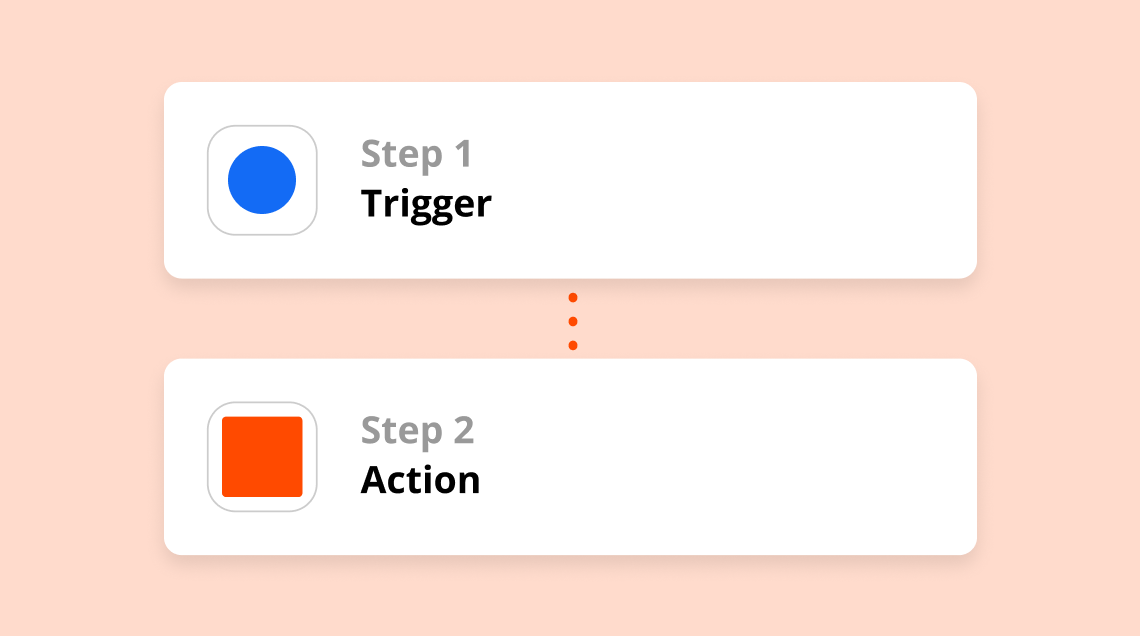
Think of these as building blocks for your Zap. Start with your trigger and add the action or actions you want Zapier to perform.
First, make sure you've signed up for a Zapier account. It's free to start!
Before you create a Zap, it's helpful to think about what you're trying to accomplish. For example, let's say you have a contact form on your website. You want to store the form submissions in a Google Sheet, but you don't want to copy and paste them manually.
Start by breaking down the problem you're trying to solve into the following:
- What apps do I want to use? (A form app and a spreadsheet app)
- What event will trigger my Zap? (When there’s a new submission in our form app)
- What event will my Zap perform? (Add the form submission to a spreadsheet)
- What information do I want to move between those apps? "(The contact’s name, email address, and the reason for contacting us)
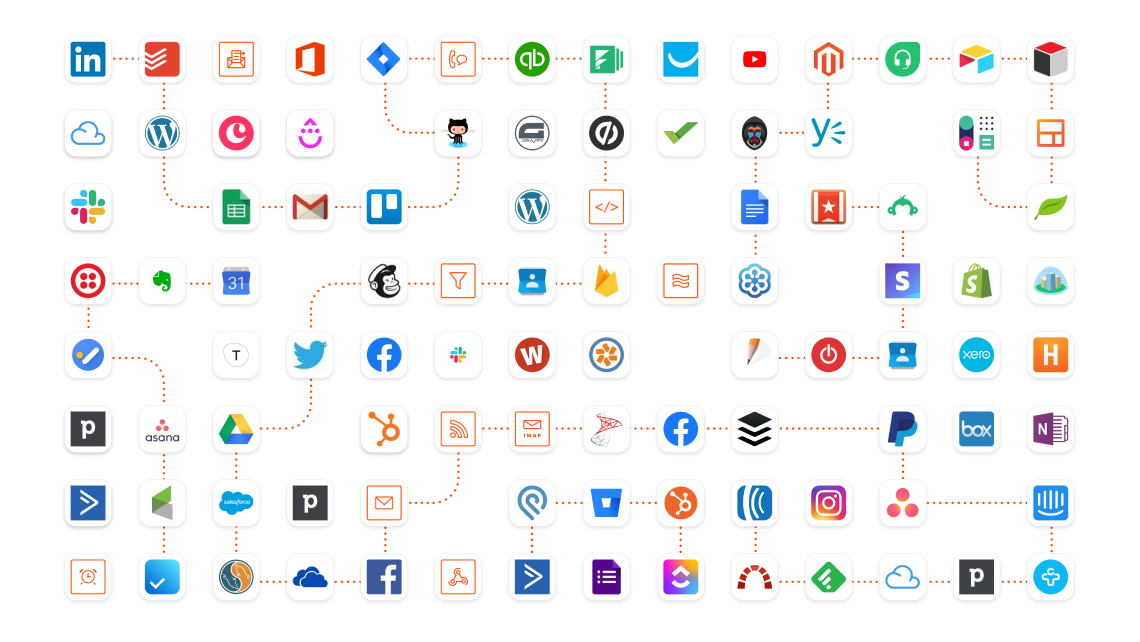
Zapier works with thousands of apps, but available triggers and actions vary by app. To learn more about what's possible with an app on Zapier, search for the app in our App Directory.
We'll walk you through how to set up your Zap with our form-to-spreadsheet example. Here are the steps:
- Prepare your spreadsheet and form.
- Set up your trigger step: Select your trigger app and event, connect to your app account and customize your trigger event, and test your trigger.
- Set up your action: Select your action app and event, connect to your app account and customize your action event, and map your fields.
- Test your Zap.
Need help setting up automation for your business? Zapier Experts are certified consultants, freelancers, and agencies that can help you do more with automation. Visit our Experts directory to help you find the right Expert to work with.
Before you get started
Create your form and enter a sample submission. It's helpful if you use information that will be recognizable to you later. For example, instead of using random characters, enter something that will make sense—you will use that data in Zapier to test your Zap. (We recommend using superhero names or fictional characters so you won't confuse your test with a real submission.)
Create your spreadsheet, and be sure to name your columns. This will be important when you set up your Zap.
Set up your trigger
The Zap editor is where you'll create new Zaps and edit existing ones.
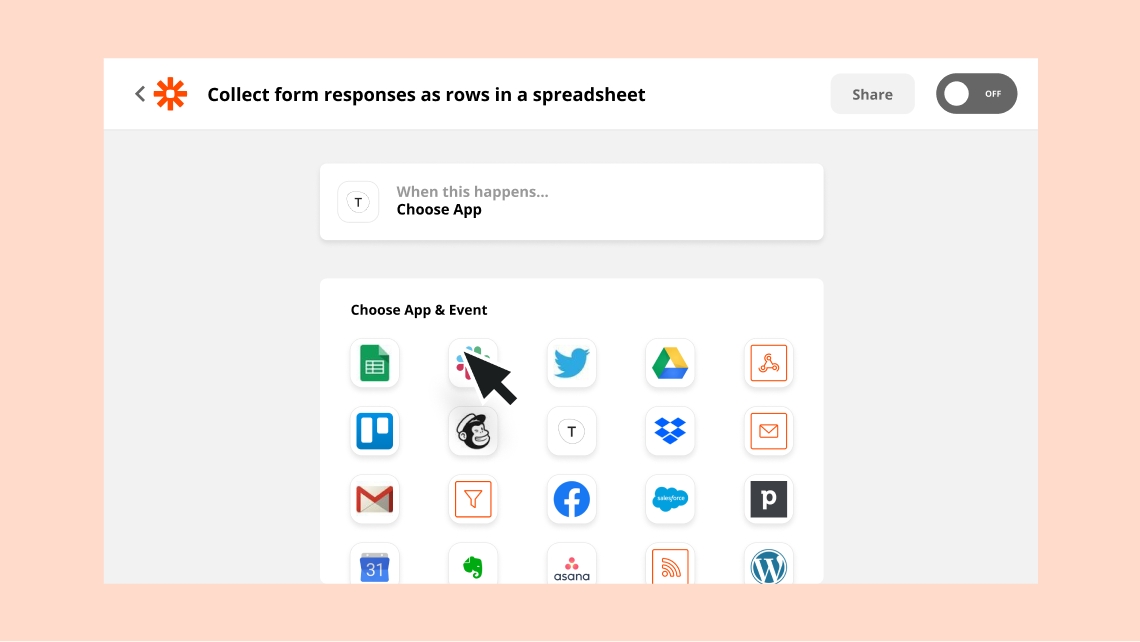
Remember: A trigger starts your Zap. (Think of it as the WHEN of any automation.)
Select your trigger app and event
When you open the Zap editor, you'll be prompted to pick an app as your trigger.
You'll see the apps you use most frequently, built-in apps from Zapier, and popular apps. You can select from one of these, or look for the app you want to use in the search bar. If you're starting from a Zap template, what we call a pre-made Zap , this will be selected for you.
Next, you'll be asked to choose a trigger event. This is the event that happens in your trigger app that signals Zapier to start your Zap. In this case, it's when a new form entry comes into our form app.
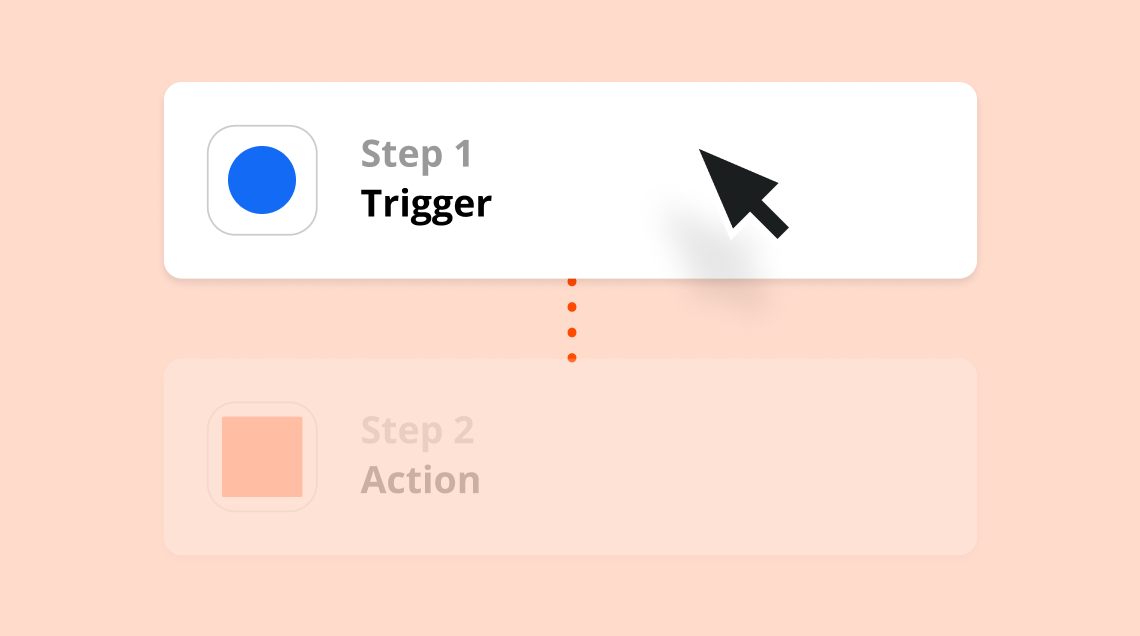
Trigger events vary between different apps and app types. For example, a task management app might have New Task as a trigger, while a spreadsheet app could have Create New Row.
Connect to your app account and customize your trigger event
You'll be prompted to sign into your app account if you haven't connected it before. Once you've connected your app, select the account you want to use with your Zap.
Note: For each app you connect, Zapier will ask for a general set of permissions which allows you to be flexible with your Zaps. The only actions Zapier takes on your app accounts are those a given Zap needs to accomplish what you've set up.
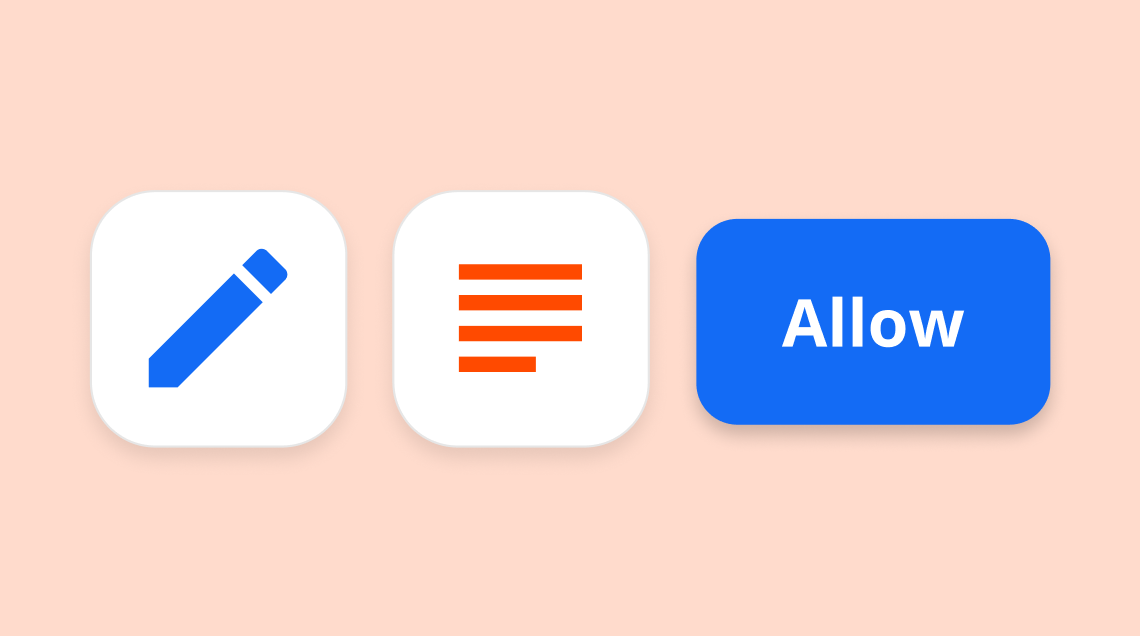
Next, you'll customize your trigger event. Click the dropdown menus in this step to select the right options. In this case, we need to select the specific form we want to trigger our Zap.
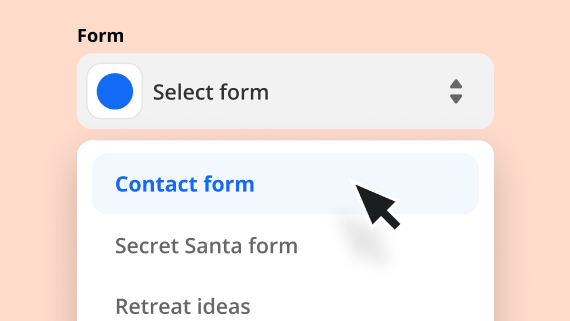
Customizing your trigger event will look different, depending on your trigger app. Sometimes, you might not need to do any further customization.
Test your trigger
Once you've set up your trigger, you need to test it to ensure it works. When you click Test trigger, Zapier will look for data that already exists in your trigger app account and pull that information into the Zap editor. That means you need to have one real instance of your trigger so Zapier can use it as a "sample submission."
In this example, we need at least one form submission to already exist in our form app in order for Zapier to use it as a "sample submission." Zapier pulls in the last form submission that our form app received. If a submission doesn't exist yet, try submitting a form before testing your trigger.
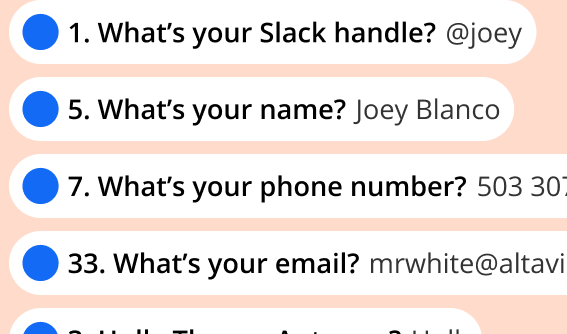
When you test your trigger, Zapier is only looking for information. It's not posting or changing any information that already exists in your trigger app.
While you have the option to skip this step, it's important to follow through. Testing your trigger ensures that Zapier can find the information you want. You'll also use this information in later steps as you continue setting up your Zap.
Look through your test data to confirm that it is pulling in the right information from your trigger event.
When you're happy with your test information, click Continue. The Zap editor will take you to set up the action step of your Zap.
Set up your action
The action is the DO part of your automation. Actions are the events you want your Zap to perform after your trigger occurs. Without an action, you don't have a complete Zap.
Select your action app and event
Just like you did with your trigger, select your action app—this time by clicking the dropdown menu and searching for your app. Once you've selected your app, choose your action event—which is what you want your Zap to do—in the second dropdown menu. If you're using a Zap template, your action app and event will be pre-filled.
In our example, we want to add form submissions to a spreadsheet. Select your spreadsheet app, and then choose the event that will create a new row. When you're done, click Continue,
Just like with trigger events, action events vary between different apps and app types. For example, a spreadsheet app might have Create a new row or Add new row as an action.
Connect to your app account and customize your action event
Next, you'll be prompted to sign in to your action app account if you haven't connected it before. Once you've connected your app, select the account you want to use with your Zap. Click Continue when you're done.
Next, the Zap editor will prompt you to further customize your action event. You will usually see Customize [action event] in the editor.
Zapier separates the data that comes in from your trigger event into individual pieces, which can then be used in your action fields.
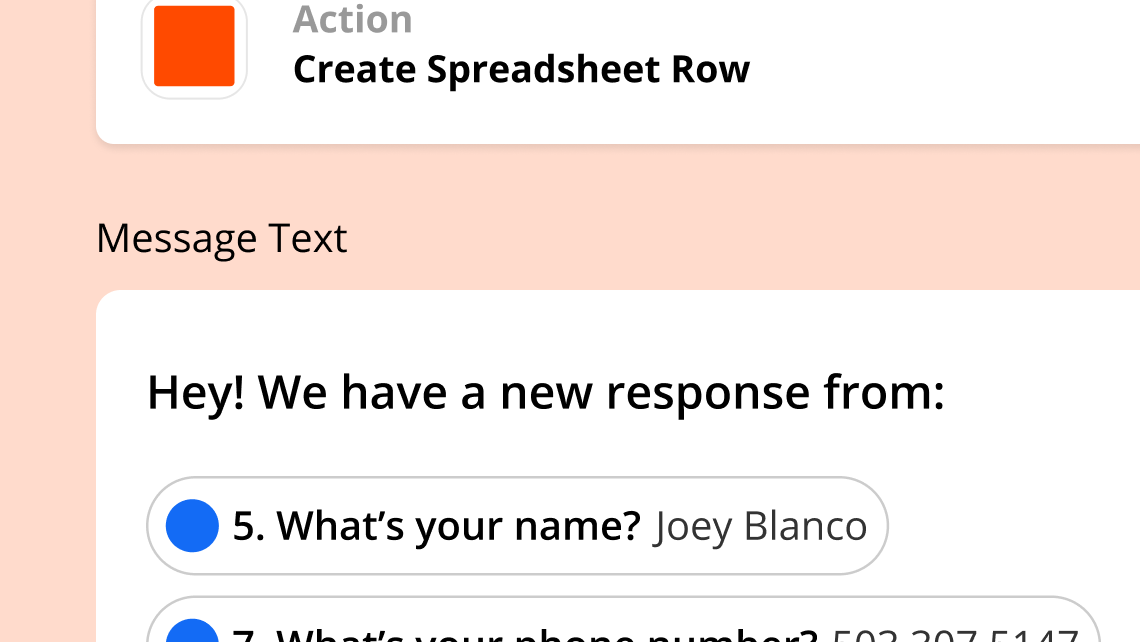
In order to get your information from App A to App B, you need to tell Zapier what information from your trigger app should be sent to which place in your action app. We call this "mapping" those fields.
Map your fields
In this example, you'll see our labeled spreadsheet columns are now fields for us to fill in with information from our form app. (This is why it's important to label your spreadsheet columns!)
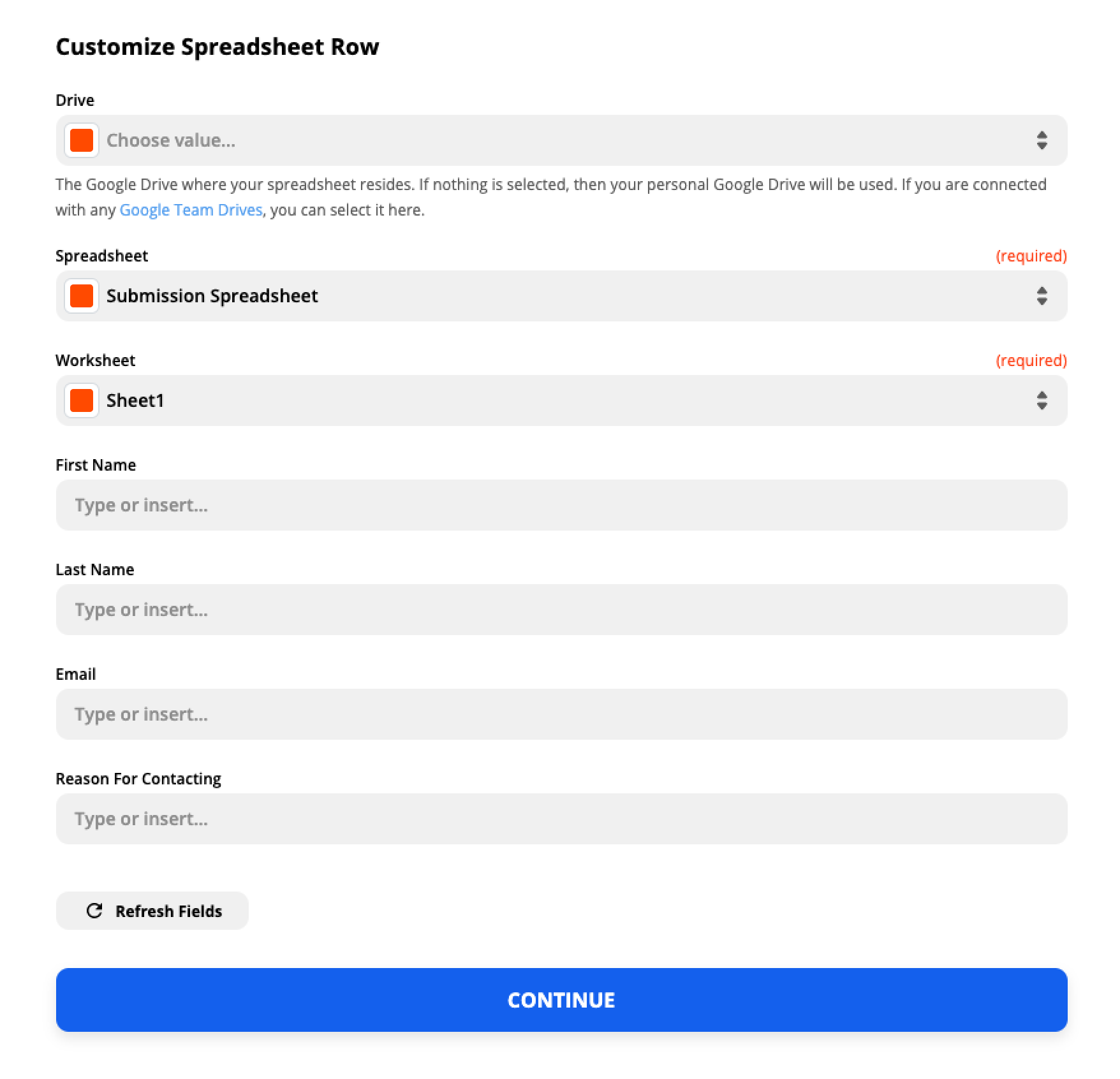
If you want to use information from your trigger app, click an empty field (indicated by Type or insert…) within your action step. A dropdown menu will appear with pieces of data from your trigger app.
The dropdown menu will show only a few options to start. If you don't see what you're looking for, click Show all options to see the full list. What you see will vary, depending on your trigger app.
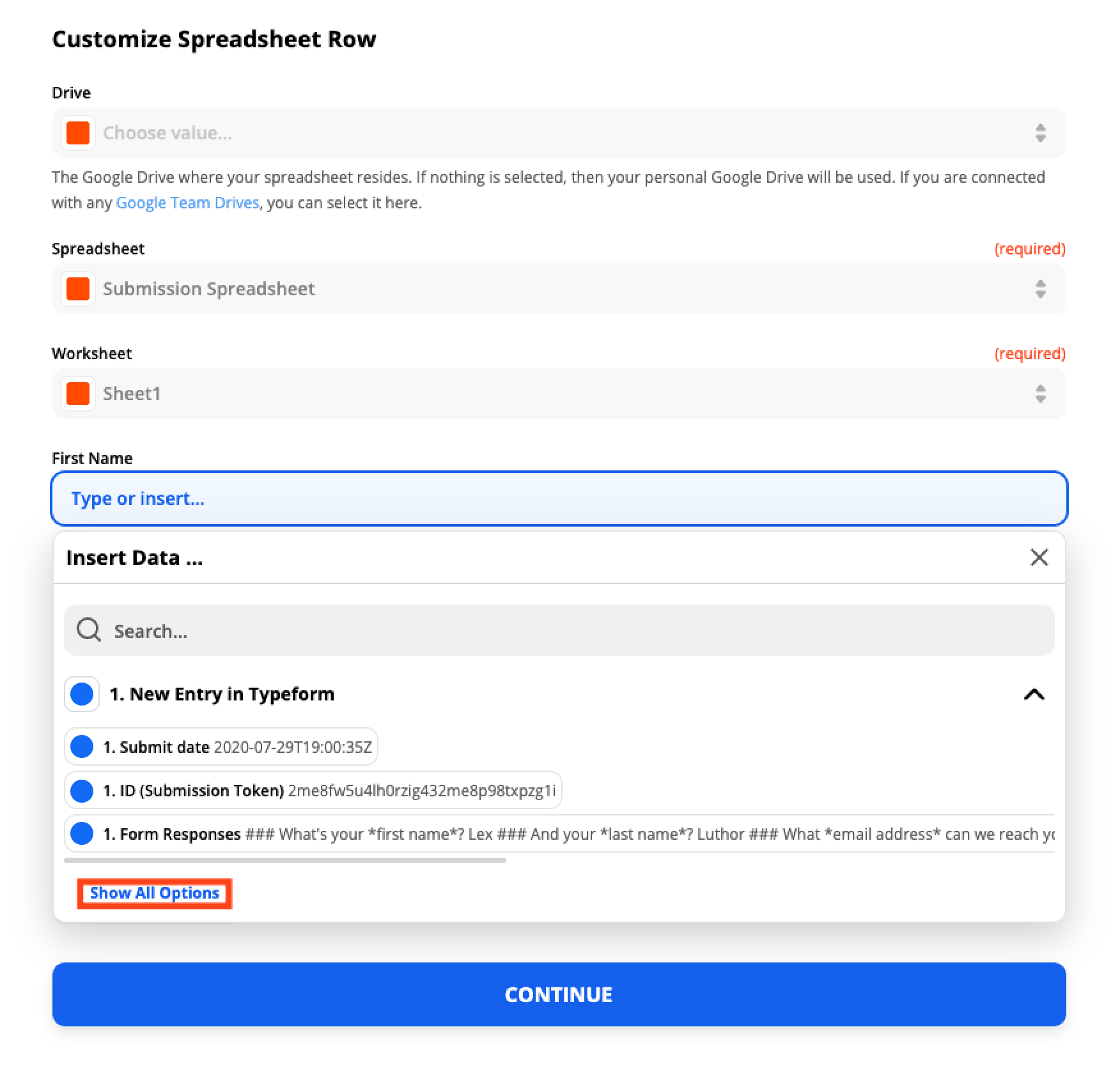
Then, select the information you want to add to each field. Think of it like multiple choice: You can select one, multiple, or no data options for any field—unless a field is labeled "required" in red.
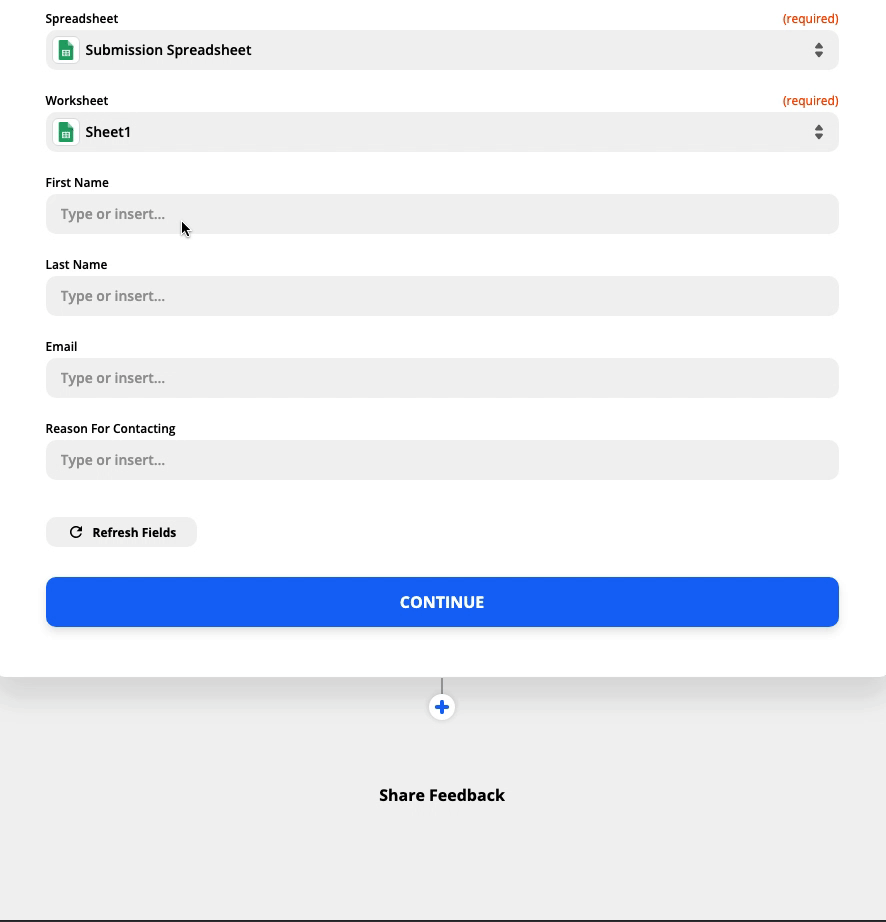
When you map a piece of data—such as a contact name—what you see in the editor is a placeholder. This placeholder data will only be used by your Zap when you test it. When your Zap is turned on, real data from your apps will be used when your Zap runs.
Once your Zap is turned on, actual data that comes through your apps will be used when your Zap runs.
For example, we see the name “Lex Luthor” appear when we map it to a field in the Zap editor, as that was the contact name we entered in the test form submission. When the Zap runs, the name of the person who submits the form will be used instead.
If you want the same information to be used in a particular field every time a Zap runs, you can enter text instead.
For example, we want to add the text “Homepage form” to each spreadsheet row the Zap creates, in order for us to know that the submission came from the homepage contact form. In the field labeled Source, we’ll enter “Homepage form.”
Once you've mapped your fields, click Continue.
Test your Zap
After you've set up your action, it’s time to test your Zap. When you click Test & review, Zapier will test your Zap by performing the action, according to how you've mapped your fields in your action step.
You'll see a preview of the action your Zap completed, but it's always good practice to check your action app to see how it looks. (This is why you should use superhero names or fictional characters in your test.)
In our example, we’ll go to our spreadsheet app to check that the right information was sent from our contact form.
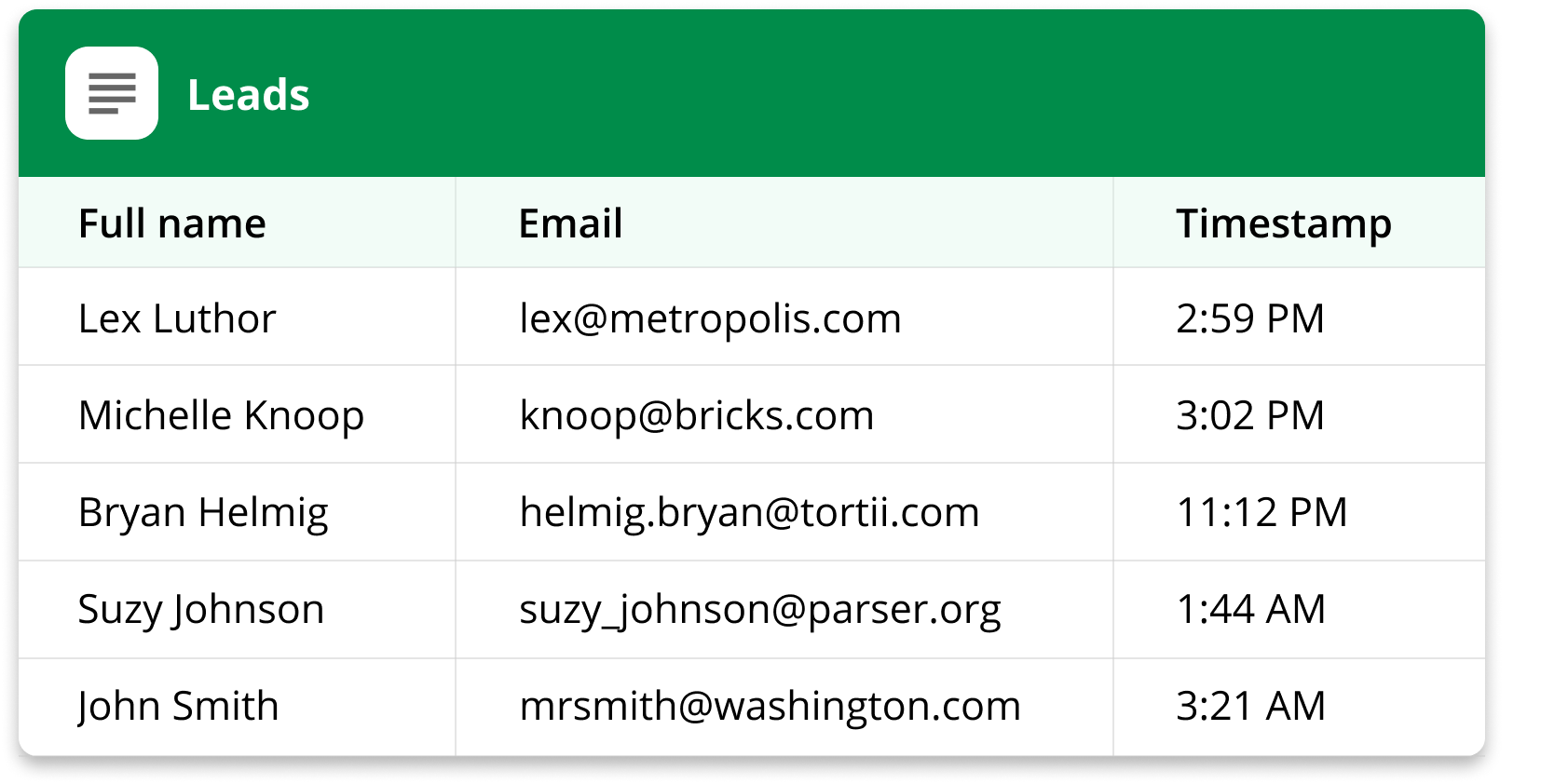
When you test your Zap, Zapier will perform the action in your action app. This means that when we test our example Zap, a new row will be added to our spreadsheet. However, it’s important not to skip the test. The test is how you'll check whether your Zap is working correctly. You can always delete changes made in your action app after you've completed the test.
If something doesn't look right, make any changes you need in the Zap editor and test your Zap again.
Once you're happy with how your Zap works, click Turn on Zap.
Note: There are pre-made Zaps—which we call Zap templates—that you can use. Just click a Zap template to begin setting it up. You'll find Zap templates in the App Directory and in many of our blog posts. When you start from a template, you'll find some selections made for you in advance, but you'll always need to connect your app accounts and confirm the setup of each step.
Tasks
Now that your Zap is up and running, it will automate tasks on your behalf. Remember: Every action your Zap successfully completes is called a task. Tasks are always associated with successful actions.
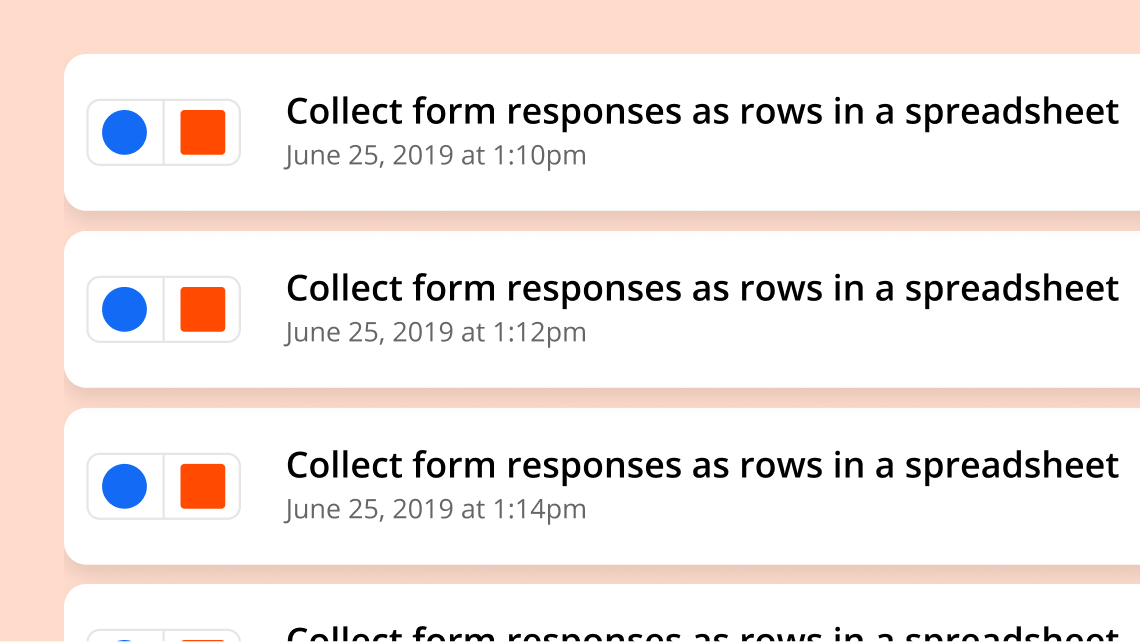
Conclusion:
Project Broadcast is an amazing tool! Plus it is very inexpensive to try and very high level features for the money. This is a no brainer to try. Plus you can get 500 FREE Credits with our Link.

